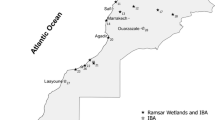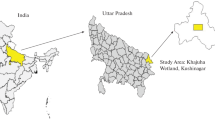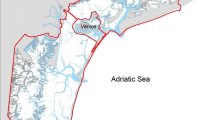Abstract
In an archipelago of marshland fragments in Central Tyrrhenian Italy, we calculated the frequency of occurrence (i.e., the probability that an individual of a sensitive species occurs in a fragment of determined size area) of a set of water-related breeding bird species. Only one species (Cettia cetti) occurred in marshland fragments within the 0–1 size area class while all species were present in larger size classes. Acrocephalus scirpaceus is the only species that showed a significant increase in frequency of occurrence moving from 0–1 to 1–10 ha size area classes. However, our study supports the hypothesis that the frequency of occurrence of several other area-sensitive species (e.g., Tachybaptus ruficollis, Ixobrychus minutus, Gallinula chloropus, Fulica atra) increases toward larger size area classes, although these trends here are not significant. Therefore, the frequency of occurrence of these species should be a focus of further research in a wider range of marshland fragments. These results will be useful in terms of wetland management implications (e.g., selection of suitable fragments for sensitive species).
Similar content being viewed by others
References
Báldi A (2004) Area requirements of passerine birds in the reed archipelago of Lake Valence, Hungary. Acta Zool Hung 50:1–8
Báldi A, Kisbenedek T (1998) Factors influencing the occurrence of Great White Egret (Egretta alba), Mallard (Anas platyrhynchos), Marsh Harrier (Circus aeroginosus) and Coot (Fulica atra) in the reed archipelago of Lake Velence, Hungary. Ekològia (Bratislava) 17:384–390
Báldi A, Kisbenedek T (1999) Species-specific distribution of reed-nesting passerine birds across reed bed edges: effects of spatial scale and edge type. Acta Zool Hung 45:97–114
Báldi A, Kisbenedek T (2000) Bird species numbers in an archipelago of reeds at Lake Velence, Hungary. Glob Ecol Biogeogr 9:451–461
Báldi A, Moskat C (1995) Effect of reed burning and cutting on breeding birds. In: Bissonette JA, Krausman PR (eds) Integrating people and wildlife for sustainable future. The Wildlife Society, Bethesda, pp 637–642
Bellamy PE, Hinsley SA, Newton I (1996) Factors influencing bird species numbers in small woods in south-east England. J Appl Ecol 33:249–262
Benassi G, Battisti C, Luiselli L (2007) Area effect on bird species richness of an archipelago of wetland fragments of Central Italy. Community Ecol 8:229–237
Benassi G, Battisti C, Luiselli L, Boitani L (2009) Area sensitivity of three red bed species breeding in Mediterranean marshland fragment. Wetl Ecol Manag 17:555–564
Bibby CJ, Lunn J (1982) Conservation of reed beds and their avifauna in England and Wales. Biol Conserv 23:167–186
Bibby CJ, Burgess D, Hill DA (1992) Bird census techniques. Academic Press, London, p 256
Blasi C (1994a) Fitoclimatologia del Lazio. Carta del Fitoclima del Lazio, Univ. La Sapienza, Regione Lazio, Roma
Blasi C (1994b) Fitoclimatologia del Lazio. Carta del Fitoclima del Lazio. Univ. La Sapienza, Regione Lazio
Brown M, Dinsmore J (1986) Implications of marsh size and isolation for Marsh Bird management. J Wildl Manag 50:392–397
Catchpole CK (1973) Conditions of co-existence in sympatric breeding populations of Acrocephalus warblers. J Anim Ecol 42:623–635
Catchpole CK (1974) Habitat selection and breeding success in the Reed Warbler (Acrocephalus scirpaceus). J Anim Ecol 43:363–380
Celada C, Bogliani G (1993) Breeding bird communities in fragmented wetlands. Boll Zool 60:73–80
Ceschin S, Cancellieri L (2007) Analisi fitosociologica delle comunità vegetali. In: Battisti C, Della Bella V, Guidi A (eds) Materiali per la conservazione delle aree umide residuali del litorale romano. Assessorato alle politiche agricole e ambientali, Provincia di Roma, Roma, pp 49–68
Cieslak M (1985) Influence of forest size and other factors on breeding bird species number. Ekol Polska 33:103–121
Cramp S, Simmons KEL, Perrins CM (1977–1994) The birds of the western palearctic, vol I–IX. Oxford University Press, Oxford
Diamond JM (1975) The island dilemma: lessons of modern biogeographic studies for the design of natural reserves. Biol Conserv 7:129–145
Ewers RM, Didham RK (2006) Confounding factors in detection of species responses to habitat fragmentation. Biol Rev Camb Philos Soc 81:117–142
Henle K, Davies KF, Kleyer M, Margules C, Settele J (2004) Predictors of species sensitivity to fragmentation. Biodivers Conserv 13:207–251
International Bird Census Committee IBCC (1969) Recommendation for an international standard for a mapping method in bird census work. Bird Study 16:249–255
Johnson DH (2001) Habitat fragmentation effects on birds in grasslands and wetlands: a critique of our knowledge. Great Plains Res 11:211–231
Lorenzetti E, Battisti C (2006) Area as component of habitat fragmentation: corroborating its role in breeding bird communities and guilds of oak wood fragments in Central Italy. Rev Ecol (Terre Vie) 61:53–68
Magurran A (2004) Measuring Biological Diversity. Blackwell Publishing, Malden
Paracuellos M (2006) Relationship of song bird occupation with habitat configuration and bird abundance in patchy reed beds. Ardea 94:87–98
Poulin B, Lefebvre A, Mauchamp A (2002) Habitat requirements of passerines and reed bed management in southern France. Biol Conserv 107:315–325
Provincia di Roma (2007) Carta della vegetazione reale della Provincia di Roma. Provincia di Roma, Roma
Regione Lazio (2006) Carta di Uso del Suolo del Lazio. Corine Land Cover Level IV. Assessorato all’Urbanistica, Regione Lazio, Roma
Saunders DA, Hobbs RJ, Margules CR (1991) Biological consequences of ecosystem fragmentation: a review. Conserv Biol 5:18–32
Snodgrass JW, Bryan ALJ, Lide RF, Smith GF (1996) Factors affecting the occurrence and the structure of fish assemblages in isolated wetlands of the upper coastal plain, USA. Can J Fish Aquat Sci 53:443–454
Sutherland WJ, Newton I, Green RE (2004) Bird ecology and conservation: a handbook of techniques. Oxford University Press, Oxford, pp 269–301
SPSS Inc. (2003) SPSS for Windows-Release 13.0 (1 Sep 2004), Leadtools (c), Lead Technologies Inc
Tews J, Brose U, Grimm V, Tielbörger K, Wichmann MC, Schwager M, Jeltsch F (2004) Animal species diversity driven by habitat heterogeneity/diversity: the importance of keystone structures. J Biogeogr 31:79–92
Tscharntke T (1992) Fragmentation of Phragmites habitat, minimum viable population size, and local extinction of moths, midges, flies, aphids and birds. Conserv Biol 6:530–536
Villard MA (1998) On forest-interior species, edge avoidance, area sensitivity, and dogma in avian conservation. Auk 155:801–805
Villard MA, Trzcinski MK, Merriam G (1999) Fragmentation effects on forest birds: relative influence of woodland cover and configuration on landscape occupancy. Conserv Biol 13:774–783
Virgόs E, Tellería JL, Santos T (2002) A comparison on the response to forest fragmentation by medium-size Iberian carnivores in central Spain. Biodivers Conserv 11:1063–1079
Wethered R, Lawes MJ (2005) Nestedness of birds assemblages in fragmented Afromontanes forest: the effect of plantation forestry in the matrix. Biol Conserv 123:125–137
Wiens JA (1989) The ecology of bird communities. Foundations and patterns. Cambridge studies in ecology, vol I. Cambridge University Press, Cambridge
Zanette L (2000) Fragment size and the demography of on area-sensitive songbird. J Anim Ecol 69:458–470
Acknowledgments
This study has been performed within the activities of the Environmental Service, Conservation Nature Office, Province of Rome. We would like to thank Francesca Causarano for her support during the field surveys and Colin Bonnington for the revision of the English language.
Author information
Authors and Affiliations
Corresponding author
Rights and permissions
About this article
Cite this article
Benassi, G., Battisti, C. Frequency of occurrence of a set of water-related bird species in an archipelago of remnant marshlands of Central Italy. Rend. Fis. Acc. Lincei 22, 11–16 (2011). https://doi.org/10.1007/s12210-010-0103-3
Received:
Accepted:
Published:
Issue Date:
DOI: https://doi.org/10.1007/s12210-010-0103-3




